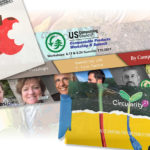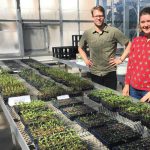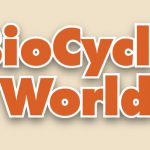BioCycle October 2015
Deja Vu Yet Again
The Oct. 4, 2015 edition of the New York Times (NYT) in its Sunday Review featured an opinion piece by reporter John Tierney, “The Reign Of Recycling.” It was eerily similar to a NYT Magazine article Tierney wrote in 1996 (“Recycling Is Garbage,” 6/30/96) in which he questioned the worth of recycling, and advocated for making life easy and throwing recyclables away. This time, he additionally aimed at yard trimmings and food waste. His bottom line — the U.S.A. has plenty of space for landfills. So why must we unnecessarily bother people to separate their recyclables and compostables? Tierney’s latest tirade is an out-of-date argument. So much has changed in 19 years, starting with widespread adoption of “resource management,” where society’s outputs (waste) are considered valuable resources with a purpose, such as feedstocks to create new products. This way of thinking acknowledges that waste disposal is part of a much larger, interconnected system with the goal of creating a circular economy, not linear, like Tierney and his colleagues prefer. Tierney’s Oct. 4 piece comes across as though he pulled his head out of the sand after 19 years, talked to a few folks who still make huge profits via landfill disposal, and decided to dust off his original article — essentially recycling the same misguided “analysis.”
BioCycle editors were asked to rebut the Tierney piece in this month’s editorial. We decided to look back to see how we responded in 1996 to the first Tierney article. Lo and behold, our founding publisher and editor, Jerome Goldstein, wrote an editorial in that July issue, titled “All The Garbage That Fits In Print.” His words ring as true in October 2015 as they did in July 1996. So we are doing our own dusting off, and recycling Jerry’s editorial.
California Bullish On Organics Recycling, Renewable Energy
California Gov. Jerry Brown signed several legislative bills into law this month that bode well for composting, anaerobic digestion, compost and biogas markets and the climate. Here’s a summary, excerpted from press releases by Californians Against Waste, a nonprofit environmental research and advocacy organization (www.cawrecycles.org):
AB 1045: Establishes a statewide policy to promote use of compost by requiring state entities to work together to establish a coordinated effort for the development and deployment of compost.
AB 876: Requires local governments to plan for the building of sufficient composting and anaerobic digestion infrastructure to process organic waste generated in their jurisdictions over a 15-year period.
SB 350: Mandates all electricity providers in the state to get at least 50 percent of their supply of electricity from renewable resources like wind and solar by no later than 2030. Also requires a 50 percent increase in energy efficiency for existing California buildings by 2030.
AB 199: Creates a sales-and-use tax exemption on purchases of equipment used for recycling and composting, as well as equipment that processes recycled materials. Businesses may apply for the exemption with the California Alternative Energy and Advanced Transportation Financing Authority, which provides similar exemptions for sustainable energy and transportation purchases with the goal of reducing greenhouse gas emissions.
Finally, on Oct. 1, the California Air Resources Board proposed a regulatory strategy to reduce short-lived climate pollutants, such as methane, black carbon, and fluorinated gases. This proposal includes adoption of regulations by 2018 to effectively eliminate landfilling of food scraps, yard trimmings and other organic waste by 2025.
How to tap opportunities created by these latest laws — as well as existing mandates and incentives — will be highlighted at BioCycle West Coast 16, April 4-7, 2016 in San Diego. See Call for Papers announcement elsewhere in BioCycle World.
Food Donation Guidance In Massachusetts
The RecyclingWorks in Massachusetts program, managed by the Center for EcoTechnology, met with state and local health officials, food rescue organizations, food banks, and established food donation programs to develop Food Donation Guidance for the state of Massachusetts. Three stakeholder meetings were held across the state in the spring of 2015; information gained from the meetings was used to create the guidance document, which provides a very helpful overview of how successful food donation programs should be structured. The introduction to the guidance outlines four major steps that must be taken to have a successful food donation program: 1) Identify the types and amounts of food to be donated; 2) Identify partner organizations in your area with which to work; 3) Determine packaging, storage, and labeling requirements to ensure food safety; and 4) Determine how food will be transported as well as pick-up frequency and quantities.
The guidance details how to implement these four steps. It also reviews food donation laws and liability protection, food date labeling law, and tax incentives for food donation. Notes RecyclingWorks: “Most categories of food can be donated. The law provides protection from liability for the donation of food that is ‘apparently wholesome’ without visible quality issues. When donating food, it is important to remember that the donation is for human consumption and needs to be handled accordingly. If food looks or smells bad — compost it!” http://www.recyclingworksma.com/donate/
Microbead Ban Signed By California Governor
The California State Assembly approved AB888 to ban the sale of personal care products containing plastic microbeads in early September, which Governor Jerry Brown signed in early October. The bill is authored by Assembly Member Richard Bloom (D-Santa Monica) and sponsored by Californians Against Waste (CAW), The Story of Stuff Project, The 5 Gyres Institute, Clean Water Action and the California Association of Sanitation Agencies (CASA). “Toxic microbeads are accumulating in our rivers, lakes and oceans at alarmingly high levels,” said Assembly Member Bloom upon the bill’s approval. “We can and must act now. Continuing to use these harmful and unnecessary plastics when natural alternatives are widely available is simply irresponsible and will only result in significant cleanups costs to taxpayers who will have to foot the bill to restore our already limited water resources and ocean health.”
Plastic microbeads measure less than 5 millimeters in diameter and are added to facial scrubs, toothpastes and other personal care products as colorants or exfoliants. A single product can contain 350,000 microbeads. They are designed to wash down the drain and are so small that they are rarely captured by wastewater filters, according to CASA. After escaping wastewater treatment, they end up in local waterways and eventually the ocean, where they attract chemicals such as PCBs and flame retardants to their surfaces. This can pose a threat to human health when fish and other organisms mistake them for food and the toxins make their way up the food chain. “I am confident that future generations will look back and wonder why these tiny pieces of plastic were ever even considered for use in products that are designed to be washed down the drain,” notes Mark Murray, CAW Executive Director.
Many natural alternatives, such as apricot shells and cocoa beans, have already successfully been used instead of plastic microbeads in personal care products. The bill was supported by over 75 water agencies, environmental and health advocacy organizations, and green businesses throughout California. The law takes effect on January 1, 2020.
Cut Food Waste With Packaging
Food packaging can play an important role in reducing food waste across the food supply chain, according to packaging specialists in a recent webinar conducted by the U.S. Environmental Protection Agency’s Sustainable Materials Management Academy. The primary sources of food waste differ fundamentally between developed and developing countries, explained Todd Bukowski, senior consultant for the Packaging Technology Integrated Solutions division of HAVI Global Solutions. For example, he said, in developing countries, up to 40 percent of food waste occurs on-farm and another 40 percent in transport and processing, due to a lack of infrastructure, as well as adequate packaging equipment and materials. And the Institute of Mechanical Engineers has estimated that between farm and table, China has a waste loss of rice of 45 percent while Vietnam’s loss rate hovers around 80 percent. To combat it, Bukowski noted, the International Rice Research Institute developed a polyethylene bag to go inside traditional jute bags, reducing moisture and concomitant mold and keeping more pests out.
Techniques like Modified Atmosphere Packaging (MAP) have already extended the shelf life of meat from 2 or 3 to 21 days, and allow products like milk to be shipped without refrigeration, which is important in developing countries. Berries are a high-value product with a traditionally short shelf life. Perforated lidding film, which allows ripening ethylene gases to escape, cut berry waste by 50 percent at the U.K.’s Marks & Spencer, while ethylene-absorbing pads increased the shelf life of strawberries in refrigeration from 4 to 6 days. Ron Cotterman, vice president of sustainability for Sealed Air Corp., who also presented on the webinar, noted how adding 25 percent more packaging to protect precooked, bone-in hams from puncturing their packaging reduced product wasted at the retail display by 73 percent.










